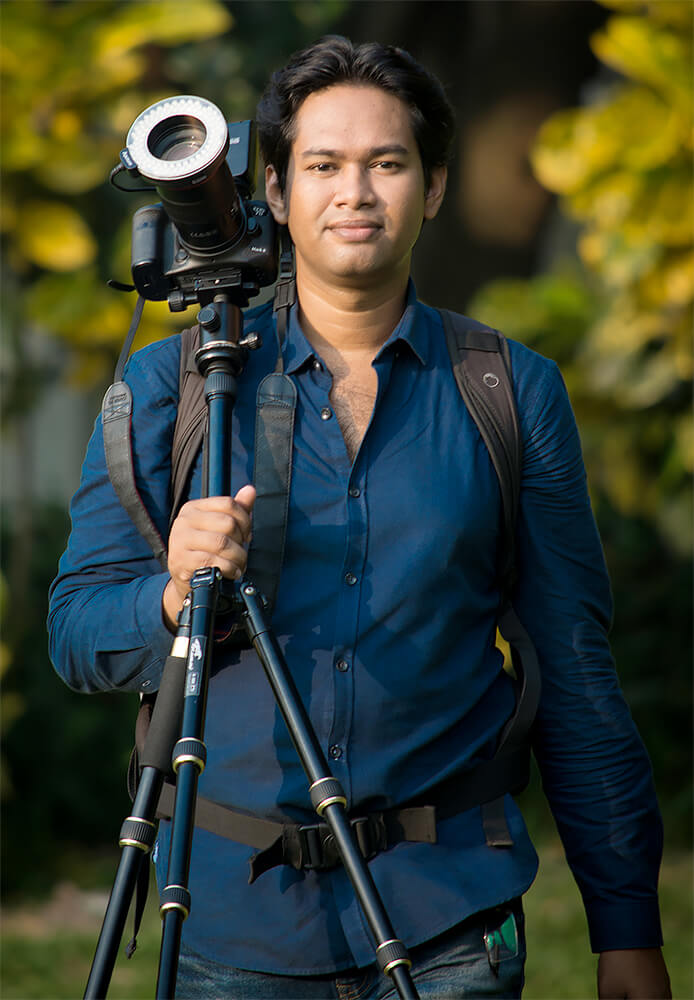Azim Khan Ronnie was born in Dhaka and brought up in Bogra, Bangladesh. He has an utter passion for photography and photography has been his passion. As a photographer, his essential aim is to capture the moments of life and give them significance by making them static in time. He loves to travel and be in different places, meet new people, and enjoy the experience that photography offers, which is to capture Earth's beautiful and awe-inspiring moments. He also loves to experiment with his photography.
He is working news channel as a senior camera person in Bangladesh. More than 15 years Azim Khan Ronnie working in TV Channel back to camera. That's why he was gain lot of photographic knowledge. He is completed foundation course from Pathshala South Asian Media Institute. He has taken part in many National and International Photography contest and till now he has won many national and international photography awards, including HIPA Merit Medal Award 2018, Andrei Stenin Press Photo Contest Winner, SIENA International Photography Award 2019, Two awards from Drone photo contest 2019, Asahi Shimbun award from Japan, Winner Agora images, Won Merit Awards from prestigious
All About Photo Awards 2020, 2nd prize from HERITAGE for PLANET EARTH® travel photo competition 2018, BBC Wildlife Photo Contest winner 2017, Won the 1st prize in Securing Water For Food Global Water-Agriculture Photo Contest 2017, FIAP Bronze Medal from 15th Adana Rotary Club International Photography Contest. 3rd Place winner from Wiki Loves Monuments 2017 international photo contest organized by Wikipedia. PSS – Dr. Gibson Hill Memorial Gold Medal (Best of Section) from Singapore International Photography Awards (SIPA) 2017, 1st prize winner from COMPAS photo competition 2017, 1st Prize winner from 35AWARDS 2016 Russia, 2nd prize winner from The 4th Student Photography Contest, organized by Global Photography, China, Grand Prize winner of Endless Summer Photo Contest from Skylum, Two times MARUMI Photo Contest Silver Prize winner from Japan, Honorable mention award from ND Awards 2017, Top 10 Winners of Click India Photography Contest 2017, 3 awards winner from "Golden Orchid International Photo Awards" 2017, 1st & 3rd Prize winner from International photo contest & exhibition in China 2015, Achieve 2nd, 3rd, 5th, 8th & 9th total 5 awards from Bangladesh's Wiki Loves Earth 2017 Photo Contest, Achieve 1st, 2nd & 7th winner from Bangladesh's Wiki loves monuments 2017 photo contest, 3rd Prize from Dhaka-Kolkata International Photo Contest 2017, The Nature Conservancy's 2017 Top 100 Photo Contest, Anjan Kumar Majumder Memorial Trophy for Best Local Nature" from MahfuzUllah Memorial International Photo Contest 2017, Honorable Mention Award from Tokyo International Photo Award (TIFA). Honorable Mention Winner from IPA-The International Photo Awards. Gold Medal Award winners in the San Francisco Bay International Photo Show. Grand prize winner from Chania Photo Festival, Greece. Awards froms VOUBS are: 1st Prize in best Landscape, 1st Prize in best Lifestyle, 1st Prize in best Travel Photo, 1st Prize in best Eyes Photo, 1st Prize in best Pet Photo, 1st Prize in best Reflection Photo, 1st Prize in best Flower Photo, 1st Prize in best Sunrise/Sunset Photo, 1st Prize in best Spring photo, 1st Prize in best Travel photo 2018, 1st Prize in best People Photo, 1st Prize in best Waterfall Photo, 1st Prize in best Baby Photo. Finalist HIPA 2018, Finalist Smithsonian 15th annual photo contest, Finalist Siena International Photography Awards 2017 & 2018, Finalist dotART Urban 2017 photo awards, Hourly Winner of CBRE Urban Photographer of the Year Photo Competition 2018, Landscape Diversity' Expert Judge Winner from Photocrowd, Won Bursa PhotoFest Medal for Contest Special Award Winning Photographs from Bursa International Photo Festival,Turkey, 1st Prize Winner of We Said Go Travel Photo contest 2018, Grand prize winner in Chania Photo Festival, Greece. First place prize in the Social Life category in Ikei Photo Contest, Spain, 2019. Award Highly Commended CBRE Urban Photographer of the Year 2016, one of my photograph has been selected for the 2019 New Internationalist Almanac and many more.
His photographs was published Switzerland, France, UK, Russia, Korea, Iran, China and many national & international newspaper & magazine include The Times, The Sun, The Guardian, Daily Mirror, The Telegraph, Daily Mail, New Atlas, BBC Wildlife Magazine, National Geographic Magazine, Smithsonian magazine, F-Stop Magazine (also cover photo), Edge of Humanity Magazine, Swiss newspaper Blickamabend, France daily newspaper (LaDépêche, 20minutes), France magazine Le Figaro, Le Parisien, View magazine in Germany, in China CCTV, Global Times, Beijing Television (BTV), Russian magazine Вокруг света (One of the oldest popular magazines in the world), GEO Magazine, The People, Popular news magazine Newsweek, SangSaeng Magazine, Korea, Canon (France, UK, Europe), Politiko, Iconstyle in Tirana, Albania, The Week Junior etc.
